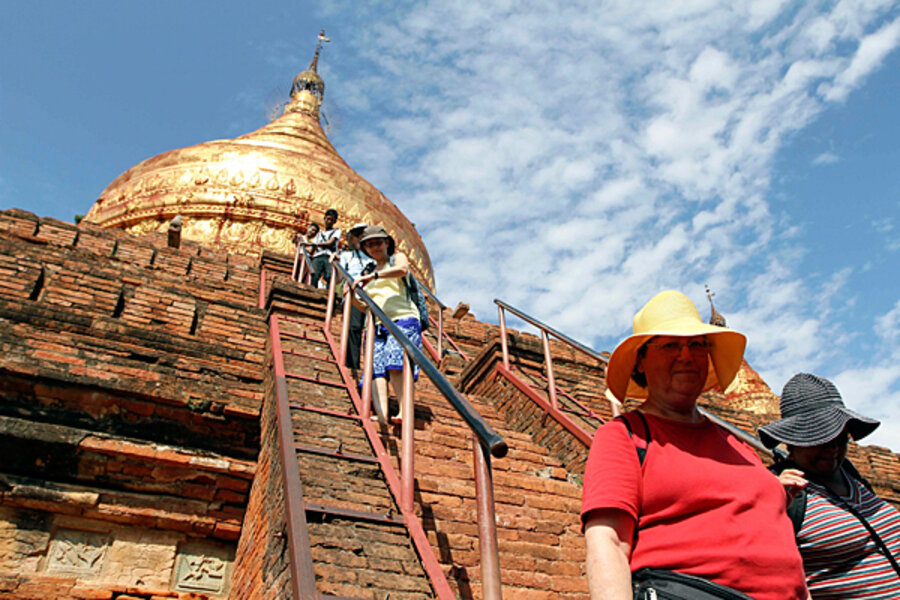Burma just opened up after 50 years. But where are all the tourists?
Loading...
| Yangon, Myanmar
It has got the beaches and temples and culture to easily rival those of popular tourist destinations Thailand and Malaysia.
At night, the politically and culturally iconic Shwedagon Pagoda glimmers 325 feet high over a darkened Yangon. The ancient city of Bagan boasts a spectacular plain of more than 2,000 temples – some more than a millennium old – a short drive from Mandalay city is the old capital of Amarapura, home to the U Bein Bridge, the world's longest teak bridge and site of hazy lakeside sunsets.
International tourists to the country will tell you that Myanmar (also known as Burma) has some breathtakingly beautiful places to visit. But here's the problem: Tourists are hard to come by.
Earlier this week, local media reported that in the first nine months of the year, 357,159 tourists entered Myanmar. It will take another year or two for Myanmar to top the 1 million tourists per year mark, says U Naung Naung Han, the general secretary of the Union of Myanmar Travel Association.
While that low number may add to its allure as an off-the-beaten-path destination, compared with the 15 million to 20 million tourists that Thailand and Malaysia both see each year, Myanmar has a long way to go to tap the benefits of a tourist economy as it comes out of five decades of Army-imposed hibernation.
“Look at the example of China,” says Larry Yu, a professor of hospitality management at George Washington University in Washington. “China opened in ‘78 and it took them more than 30 years to become one of the Top 5 tourism destinations in the whole world,” he says adding that because of its size, China was in a better position than Myanmar to absorb large numbers of visitors.
“A lot of tour operators have been trying to attract people for many years, but there was political instability and people were reluctant to visit,” says U Naung Naung Han. However, he says that things are actually looking good as more people become aware of the Myanmar government's ongoing economic and political reforms, and since opposition leader Aung San Suu Kyi dropped her long standing support for a tourist boycott as a means of denying revenue and legitimacy to Myanmar's military regime.
Although Myanmar’s tourist numbers are still low, investor visits are on the rise, highlighting poor infrastructure and raising the question of whether Myanmar is actually ready for an influx of visitors.
Already-scarce hotel rooms are being booked up by business delegations and almost-daily investment conferences talking up what is widely-touted as one of the world's last oil and gas “frontier markets.”
The Traders Hotel lobby functions as a de facto meeting room for would-be investors and their local contacts, and amid the din of consultant chatter, staff say that the hotel is booked until the end of November, despite a $186 minimum room price. “If you book in the next couple of days, you might get a room for early December,” advises the person at the reservations desk.
For visitors without expense accounts, $200 nightly room rates are likely too much, but there's not much else on offer, as rooms at mid-range hotels are also being snatched up by corporate visitors.
At Yangon's Central Hotel, marketing manager Ko Ko Naing says that business has increased 30 to 40 percent in the past two years as reforms kick in.
“Mostly we have Asian guests here for business, but more and more Westerners are coming,” he says.
Asked what needs to change to boost tourism in Myanmar, Ko Ko Naing gives a one word answer, “infrastructure,” adding that better roads and rail are needed, as well as a more reliable power supply.
Despite those plentiful natural resources so beguiling to potential investors, only 25 percent of Myanmar's population has electricity, and even then blackouts are common. “When it is 40 degrees [C, or 104 degrees F.], visitors want to know for sure the A/C works,” says Ko Ko Naing.








